Are you curious about how the resin in your water softener works? Want to learn more about why it has to be regenerated and when it should be replaced?
You’re not alone. This guide provides helpful, professional information on all things water softener resin.
Hard water is a nuisance for many homeowners. Not only does it leave spots on dishes and make laundry harder to clean, but it can also damage fixtures over time. A water softener can help solve these problems – and the ion exchange resin is the heart of the system that allows it to soften your water.
Continue reading to learn more about water softener resins. You’ll pick up some valuable information and useful tips for getting the most out of your system.
Table of Contents
What Does the Water Softener Resin Do
Water softeners remove hardness minerals from water through a process known as ion exchange. The ion exchange resin swaps sodium ions for the calcium and magnesium ions in the water.
In simple terms, the undesirable hard minerals change places with the benign sodium ions that are on the media. This is why you want to avoid running out of your water softener salt.
Want to learn more about water softeners? Read my complete guide to water softeners.
Water hardness
Before we talk about water softener resin, we need to discuss water hardness. Hardness is a measure of the amount of calcium and magnesium in water. These two minerals are what make water hard.
Hard water isn’t unsafe to drink – in fact calcium and magnesium are essential for our health. Hard water is, however, a nuisance. It can damage fixtures, make laundry difficult to clean, clog your pipes, and leave spots on dishes.
Hard water can cause a number of problems around the house, including:
- Dry skin
- Brittle hair
- Dingy and stiff laundry
- Spots on dishes and glassware
- Reduced soap and detergent effectiveness
- Clogged pipes
- Scale buildup on fixtures and appliances
If you’re experiencing any of these problems, you almost certainly have hard water. You’re not alone. More than 85% of the United States has hard water, according to the U.S. Geological Survey.
Ion exchange process

Ion exchange is a water treatment process where an undesirable ionic contaminant is removed from the water by being exchanged for another non-objectionable substance. Both substances must have identical electrical charges – either positive or negative.
Water softening is the most common example of ion exchange technology. Calcium and magnesium are exchanged (i.e. replaced) by sodium.
Water softeners use ion exchange resins to remove hard water minerals. The resin is made up of small spherical beads that have a negative charge. This charge attracts the positively charged hardness ions in the water and traps it on the surface of the resin.
The resin beads are pre-loaded with a coating of positively charged sodium ions before they are used to treat hard water. This step is important in the water softening process.
Keeping the chemistry simple, there are only three things you need to know to understand ion exchange.
- The resin has a negative charge
- Calcium and magnesium ions have a positive charge
- Opposites attract
Regeneration of resin
The resin in a water softener removes the calcium and magnesium from the untreated hard water very effectively. Over time, the media becomes saturated with these minerals and can’t remove any more of the hardness.
At this point, it is essentially “full” and has to be regenerated. Regeneration is the process of restoring the capacity of the resin. This is done by flushing the media with a high concentration of salt (or potassium) solution.
The high concentration of salt ions “knocks off” the calcium and magnesium ions that are clinging to the resin beads. These hardness minerals are then flushed down the drain. The process of regeneration restores the capacity of the water softener so it can continue to remove hardness from the water.
Most home water softeners will regenerate automatically on a schedule – typically once per week. The specific frequency will depend on your system, the hardness of your water, and how much water you use.
I wrote a comprehensive article on water softener salt.
What Is the Resin in Water Softeners
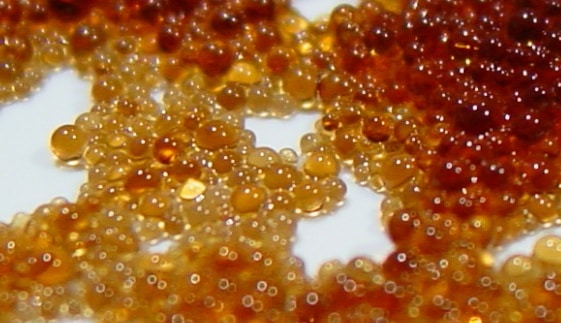
Ion exchange resins are small, microporous beads that are made of organic polymers. Throughout this matrix are ion exchange sites that are called functional groups. For water softening, the resin consists of negatively-charged ions (anions) that are affixed to the polymer network. These negatively charged functional groups attract hardness ions that have a positive charge.
What are water softener resin beads made out of?
The term “resin” refers to the strongly acidic polystyrene copolymer that is used to soften water. Water softeners use strong acid or cationic resin to remove minerals from water.
Divinylbenzene (DVB) is a chemical compound used to strengthen water softener resin beads. Increased DVB cross-linking will increase the physical strength of the resin bead and the resistance of the resin bead to oxidation. A crosslink is a chemical bond that connects two polymer chains together. Cross-linking holds the beads together so that they will last longer.
Polystyrene-type gel resins are the most widely used media in water softening. This material has a very porous, skeletal structure. The typical bead ranges in diameter from 0.3 to 1.2 mm wide. Water softener resin has an average moisture content of 45%
Are all water softener resins the same?
The vast majority of water softeners use the same type of resin. This might be surprising because there are so many different brands of water softeners on the market. The reason for this is that there is only one type of resin that is well suited for water softening – cross-linked styrene divinylbenzene strong acid cation resin in bead form.
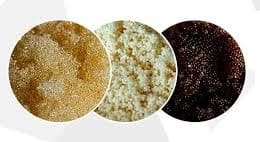
You will find several colors of water softener resins available. The most common colors are black, brown, orange, and white. The color doesn’t affect how well the resin performs – except for white which is made for removing tannins and color.
Most water softeners use a food-grade resin. This type of media is certified (usually by NSF) to ensure no toxic substances such as lead or bacteria are introduced into your water.
There are many different names for the resin in your softener. Some terms you may hear include:
- fine mesh resin
- resin beads
- softener resin
Read my article about water softener maintenance to learn more.
Types of water softener resin
Here are some of the most popular types of water softener resins used in residential and small commercial water softeners:
- 8% cation resin – This is the most commonly used resin. It is an 8% cross-linked cation gel, in sodium form.
- Fine resin – This is a small diameter bead that has a greater surface area (on a volume basis). It is marketed as having a higher capacity than conventional resin.

Here are the most commonly used brands of water softener resin:
- Dow HCR-S
- Purolite C-100
- Purolite C-100-E
- Resintech CG8
- Resintech IWT C-211
- Rohm & Haas IR-120
- Sybron C-249
- Sybron C-267
- Thermax T-42
A typical specification for water softener resin looks like the following:
Total exchange capacity: 2.0 meq/g min
Ionic form: Na (sodium
Water retention: 43-48%
Screen size: 16-40 mesh
Bulk density: 0.78 – 0.88 g/ml
Each manufacturer has their own specific formulation of water softener resin. The ingredients and ratios are a closely guarded secret. However, all resins are essentially the same.
Special purpose resins – fine mesh resin
If your water has difficult chemistry, then you may need a specialty resin for your water softener. One of the most common issues is high levels of tannins in water. Tannins are organic molecules from plant debris that can leave behind a yellow or brown stain on fixtures and laundry.
If your water has high tannins or a lot of color, you may need a “white resin”.
White Resin, also known as tannin acrylic gel, is a strong base anion exchange material. It is used to remove color from tannic acid in your well water supply. This media can address color in water, including water with a slight yellow or brown tint as well as water that is darker like iced tea.
Water softener tank
The resin is held in a special vessel called the water softener tank. This tank is rated for pressure to allow your home’s tap water to flow through the ion exchange resin at the psi your water is supplied at.
When to Replace the Resin in Water Softener
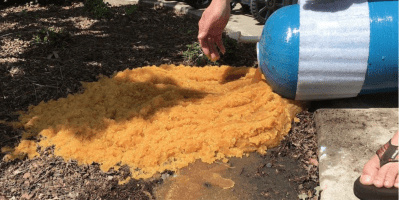
The resin in your water softener doesn’t last forever. However, it should last many years (10 or more) if you do all of the required maintenance, and your system isn’t undersized.
How to know when it’s time to replace resin
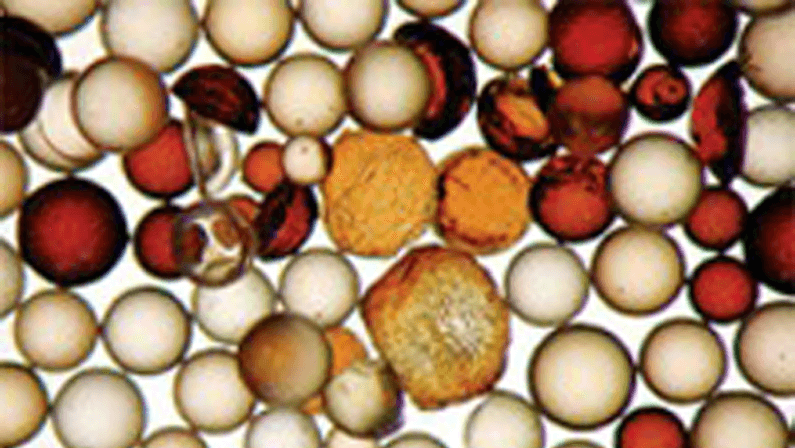
There are five main reasons you will have to replace your water filter media. These are:
- chlorine damage
- algae growth
- silt and solids accumulation in resin bed
- bacteria contamination
- iron fouling
Chlorine Damage: The number one reason you’ll have to replace your resin is damage from chlorine. If your tap water is highly chlorinated, the chlorine will oxidize the resin. This reaction damages the pellets, causing them to break down and become swollen. After about 10-years (depending on residual chlorine levels) the pellets swell and degrade. This expansion causes the media to crumble into small pieces known as “fines”.
These tiny particles can clog up screens in faucets and appliances. You may notice some dark particles in your water.
Algae Growth: Water softener resin can become contaminated with algae growth, which is a common problem in tanks installed outside. You can check for algae by opening the tank and looking at the media. It will have a distinct blue-green color and the fuzzy accumulation of algae.
Silt and Solids Accumulation: If you get your water from a well, you may have a problem with fines and suspended particles. These solids can accumulate in the resin bed of your water softener. Over time, they can block the flow of water, eventually resulting in low flow and poor water pressure.
In order to solve this issue, you may need to dump or suck out all the resins and sand – not an easy task! Replacing the old resin with new ones is much simpler.
It’s virtually impossible to remove the sand and silt from your resin tank. The only way to solve the problem is to replace the fouled media with new resin.
Bacteria Contamination: If your resin tank has been unused for several months, the stagnant water can become contaminated with bacteria. You’ll notice this problem because of the strong, unpleasant odor in the resin tank.
The best way to deal with this issue is to clean and disinfect the resin tank. You can try cleaning the media with a chlorine (bleach) solution. In my experience, simply rinsing your resin with bleach won’t be enough and you’ll need to replace the bed with fresh resin.
Iron Fouling: If you’re having trouble with your water softener because of iron fouling, don’t worry – there are ways to clean it. You can add a heavy dose of iron removal cleaners.
Cleaning solutions that you can use to remove iron from your water softener resin include:
- Res-Up
- Reskleeen
- Iron Out
- Citric Acid
- Bleach

If these cleaners don’t work, you will have to replace the resin.
Testing resin performance
The best way to evaluate how well your water softener’s resin is working is to test your treated water. I routinely test the hardness of my softened water to keep track of how well it’s working. Once a month is generally adequate.
I test my water using a total dissolved solids (TDS) meter. This instrument measures the dissolved minerals in your water. The TDS level will be lower after the water has been through your softener.
My softened water typically has a TDS level of between 70 and 95 parts per million (ppm). If I see the TDS concentration start to creep up, I know something’s wrong. Usually, I just need to adjust the backwash settings. However, on occasion this means it’s time to clean or replace my resin bed.
Find the best hardness test kit for your needs in this article.
How often should water softener resin be replaced?
The resin in your water softener does not last forever. The media is damaged from oxidation (by chlorine), biological fouling, iron scaling, and abrasion due to backwashing and flow changes.
Most manufacturers recommend replacing the media every 10 years. This is just a general recommendation. The actual life of your resin can vary significantly depending on the conditions in your water.
The two biggest variables are the chlorine level in your tap water and the volume of water you use. As these two factors increase, you can expect a reduction in the life of your resin.
Does resin go bad?
Water softener resin doesn’t “go bad”. This implies that it has a shelf life like milk does.
The resin is made of a polymer, and these materials last a very long time as long as they’re not exposed to extreme conditions (like UV light or harsh chemicals).
There are many ways that the resin bead can fail. Some of the most common causes of resin failure are:
- Oxidation (chlorine in tap water) – The chlorine in your water reacts with the polystyrene gel and damages the ion exchange sites.
- Biological fouling – Bacteria and algae can grow on the surface of the resin beads, blocking the ion exchange sites.
- Water hammer – The sudden change in water pressure and flow direction can damage the bead.
- Fouling – Dissolved metals such as iron and manganese can clog the pores of the media.
- Abrasion – Backwashing and changes in water flow direction causes damage as the beads rub against each other and the media vessel.
- Osmotic shock – As resin beads exhaust and regenerate, they swell and contract. The beads will gradually break and/or crack over time.
How to Replace Water Softener Resin
Can you replace resin yourself
Replacing the resin in your water filter system is not difficult. However, it does take a little bit of time and effort. You also need to be a little “handy” to do it properly.
Step-by-step process to replace your water softener resin
If you’re a little handy, then you can replace your water softener resin yourself.
You’ll need to purchase the resin, which is available from most water treatment dealers or online retailers. Be sure to get the right type of resin for your system.
It’s important to follow the directions in your owner’s manual. Each system is a little different. If you have any questions, it is best to contact the manufacturer of your water softener for assistance.
Here’s a step-by-step guide on how to do it:
- Shut off the water supply to your softener.
- Empty the resin tank by tilting it on its side and pouring out the water and resin. If this is not possible, use a shop vacuum to remove them.
- Clean the inside of the tank with chlorine (bleach) if necessary.
- Pour in the new resins using a funnel. A second person to help with this step is recommended, but can be done solo with patience.
- If using gravel under bedding, add it now and cover the top opening of the distributor tube to prevent any debris or resin from entering.
- Fill the tank with water until the resin is completely covered, then push down the distributor tube until it hits bottom. Mount/screw on valve controler.
- Add gravel if using it as bedding (if not already done).
- Follow steps 3, 2, 1 in reverse order to reassemble the unit.
- Backwash your new resin for 10 minutes using your control valve (all valves have a way to manually advance them to backwash). You can run a complete regeneration cycle if desired, but it’s not necessary as the resins come fully charged.
- Run water through system for a few minutes to clear lines of air, and you’re done!
How much does water softener resin cost
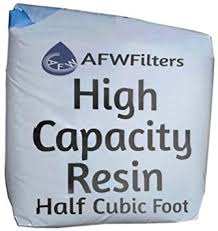
Water softener resin is readily available from most water treatment dealers and online retailers. The cost of the resin will vary depending on the type you need for your system, but it is generally in the range of $30 to $50 per 5 cubic foot (cu ft).
Residential water softeners have resin tanks that range in volume from 0.5 to 2.5 cu ft. A standard sized tank uses about 0.75 cu ft of media, so a complete replacement would be about $35.
Learn more about the cost of water softeners in my article here.
How much resin does a water softener take
The amount of resin your system requires depends on the size of your resin tank. The following table lists the most common tank sizes and the amount of resin they hold:
| Resin Tank Size | Resin Quantity | Gravel Base |
| 7″ x 44″ | 0.50 cu. ft. | Not Required |
| 8″ x 35″ | 0.64 cu. ft. | NONE Not Required |
| 8″ x 44″ | 0.75 cu. ft. | Not Required |
| 9″ x 35″ | 0.75 cu. ft. | Not Required |
| 9″ x 40″ | 1.00 cu. ft. | Not Required |
| 9″ x 48″ | 1.00 cu. ft. | Not Required |
| 10″ x 35″ | 1.00 cu. ft. | Not Required |
| 10″ x 40″ | 1.00 cu .ft. | Not Required |
| 10″ x 44″ | 1.25 cu. ft. | Not Required |
| 10″ x 54″ | 1.50 cu. ft. | 16 lbs. (optional) |
| 12″ x 48″ | 2.00 cu. ft. | Not Required |
| 12″ x 52″ | 2.00 cu. ft. | 20 lbs. (optional) |
| 13″ x 54″ | 2 – 2.50 cu. ft. | 35 lbs. (optional) |
Another thing to consider is the height of your tank. Tanks that are taller than 44″ should only be filled to 55 to 60% capacity. Shorter tanks should be filled as much as 80% capacity.
FAQs
How long does resin last in water softener?
Your water softener resin can last indefinitely if it’s properly maintained. However, over time the beads will break down and need to be replaced. The industry standard lifespan for resin is about 10 years.
Can I clean my water softener resin?
Yes, you can clean your water softener resin if it becomes fouled with iron or rust. If your home has a carbon water filter, you’ll want to clean the resin annually to protect the carbon.
Is water softener resin harmful?
Water softener resin used in residential units is “food grade” and considered to be safe. However, the resin is made of polymers and should not be ingested.
Which water softener resin is best?
Virtually all water softener resins are the same. The difference is in the price and how they are packaged.
Some companies sell “bulk” resin that is not prepackaged. This type of resin is usually the least expensive but can be more difficult to handle because it’s loose.
Other companies sell their resin in pre-measured bags. This type of resin is more expensive but is easier to handle because you don’t have to measure it yourself.
The type of resin you choose is a matter of personal preference.
How do I dispose of the old water softener resin?
Water softener resin is not hazardous or toxic. Many people dispose of it by placing it in their garbage. Some people spread it in their yard or garden, but I would advice against this because the resin doesn’t break down (it’s a plastic material). Check your local regulations for the proper way to dispose of it in your area.
Conclusion
If you’re a homeowner who has recently had a water softener installed, or if you’re considering having one installed, it’s important to understand how it works and how to get the most out of it. The resin is the key to water softening.
In this article, we’ve outlined the basics of the ion exchange process and explained what happens during regeneration of the resin. We’ve also provided some tips on how to tell when it’s time to replace the resin in your water softener and walked you through the replacement process step-by-step. Hopefully, this information has improved your understanding of water softener resin and will help you make decisions about its care and maintenance.

